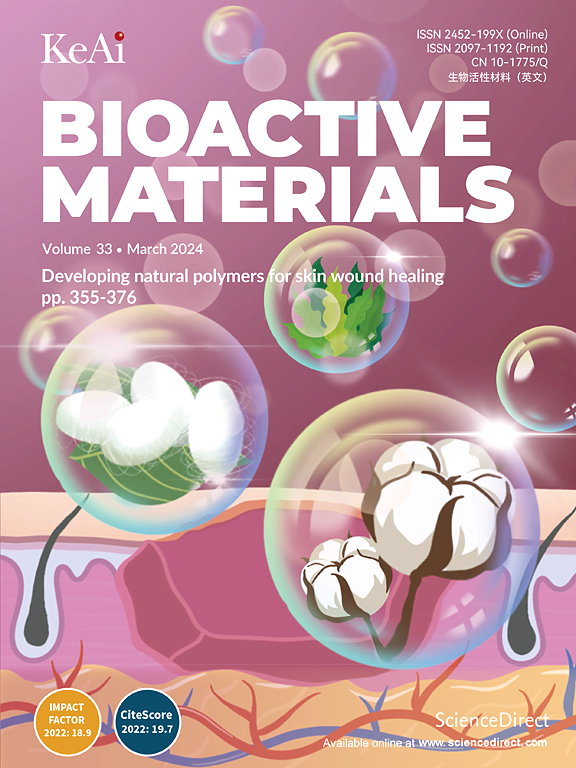A bio-inspired screwed small-diameter vascular graft for endotheliazation and arterial regeneration
IF 18
1区 医学
Q1 ENGINEERING, BIOMEDICAL
引用次数: 0
Abstract
The frequent failures of small-diameter vascular grafts (SDVGs) mainly result from thrombosis and insufficient endothelialization. Despite recent biochemical modification strategies aiming to enhance long-term patency, the challenges of suppressing thrombosis and promoting rapid endothelialization persist. We thus designed a biomimetic three-layer flexible vascular graft scaffold. This scaffold precisely replicates the nonlinear mechanical responses of vascular tissues and promotes vascular regeneration by minimizing the mechanical mismatch between the graft and the host. The biomimetic flexible SDVG scaffold comprises a screwed inner layer, a middle fabric layer, and a Polyethylene terephthalate (PET) helical coil. It shows excellent bending resistance and resilience, reducing thrombosis formation caused by impaired blood flow during bending. Moreover, this scaffold notably improves the adhesion, spreading, proliferation, and elongation of endothelial cells, facilitating luminal remodeling and maintaining long-term patency through its intimal topography. In vivo studies demonstrate that the endothelial layer forms within three months of implantation, ensuring long-term patency. By three months after implantation, both the endothelial and smooth muscle layers are regenerated, developing hierarchical microstructures and compositions similar to those of native vessels. The biomimetic flexible vascular graft with screwed structures exhibits excellent bending resistance and enhanced vascular remodeling, thereby promoting blood vessel regeneration and showing strong potential for clinical translation.

用于内皮化和动脉再生的生物启发螺纹小直径血管移植物
小直径血管移植失败的主要原因是血栓形成和内皮化不足。尽管最近的生化修饰策略旨在提高长期通畅,但抑制血栓形成和促进快速内皮化的挑战仍然存在。为此,我们设计了一种仿生三层柔性血管移植支架。这种支架精确地复制了维管组织的非线性机械反应,并通过最小化移植物和宿主之间的机械不匹配来促进血管再生。该仿生柔性SDVG支架包括螺纹内层、中间织物层和聚对苯二甲酸乙二醇酯(PET)螺旋线圈。它具有优异的抗弯曲性和弹性,减少弯曲过程中血液流动受损引起的血栓形成。此外,该支架显著改善内皮细胞的粘附、扩散、增殖和伸长,促进管腔重塑,并通过其内膜地形维持长期通畅。体内研究表明,内皮层在植入后3个月内形成,确保长期通畅。植入后3个月,内皮和平滑肌层都再生,形成与天然血管相似的分层微结构和成分。螺旋结构的仿生柔性血管移植物具有优异的抗弯曲性和增强的血管重塑,从而促进血管再生,具有很强的临床应用潜力。
本文章由计算机程序翻译,如有差异,请以英文原文为准。
求助全文
约1分钟内获得全文
求助全文
来源期刊

Bioactive Materials
Biochemistry, Genetics and Molecular Biology-Biotechnology
CiteScore
28.00
自引率
6.30%
发文量
436
审稿时长
20 days
期刊介绍:
Bioactive Materials is a peer-reviewed research publication that focuses on advancements in bioactive materials. The journal accepts research papers, reviews, and rapid communications in the field of next-generation biomaterials that interact with cells, tissues, and organs in various living organisms.
The primary goal of Bioactive Materials is to promote the science and engineering of biomaterials that exhibit adaptiveness to the biological environment. These materials are specifically designed to stimulate or direct appropriate cell and tissue responses or regulate interactions with microorganisms.
The journal covers a wide range of bioactive materials, including those that are engineered or designed in terms of their physical form (e.g. particulate, fiber), topology (e.g. porosity, surface roughness), or dimensions (ranging from macro to nano-scales). Contributions are sought from the following categories of bioactive materials:
Bioactive metals and alloys
Bioactive inorganics: ceramics, glasses, and carbon-based materials
Bioactive polymers and gels
Bioactive materials derived from natural sources
Bioactive composites
These materials find applications in human and veterinary medicine, such as implants, tissue engineering scaffolds, cell/drug/gene carriers, as well as imaging and sensing devices.
 求助内容:
求助内容: 应助结果提醒方式:
应助结果提醒方式:


